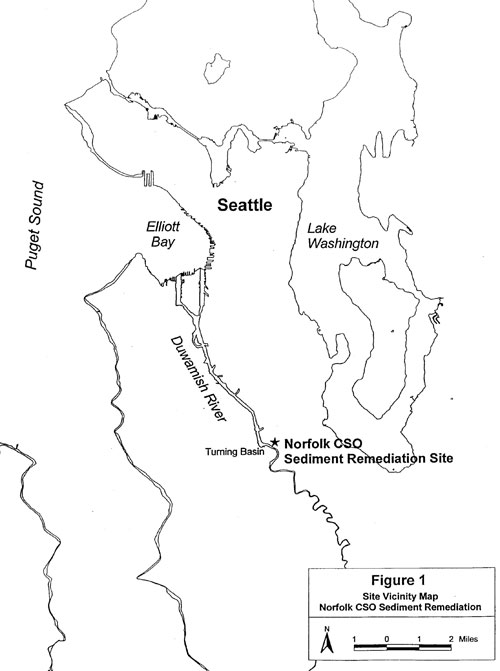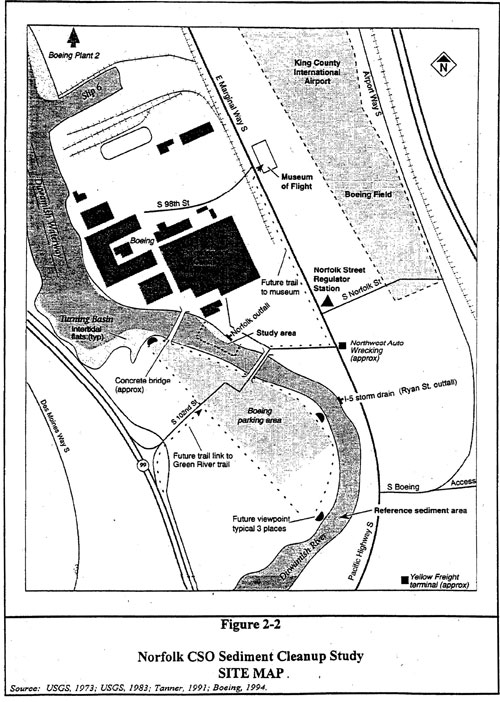Norfolk Regulator Station Overflow Sediment Remediation Project
Information about King County’s project at the Norfolk Regulator Station (RS) Overflow to address historical sediment contamination near County combined sewer overflow (CSO) outfalls.
This project was part of the Elliott Bay/Duwamish Restoration Program, or EBDRP. EBDRP is the result of a 1991 legal settlement reached by the City of Seattle and King County (then the Municipality of Metropolitan Seattle, or Metro) with the National Oceanic and Atmospheric Administration, or NOAA.
The EBDRP settlement projects include sediment remediation, habitat development and improvements, and pollution source-control measures. The U.S. Fish and Wildlife Service, Washington State Department of Ecology (Ecology), Suquamish Tribe, Muckleshoot Tribe, NOAA, City of Seattle and King County administer the program and make up the EBDRP Panel.
The U.S. Environmental Protection Agency, Ecology, King County and City of Seattle worked together on source control, project planning and design for the Norfolk CSO Sediment Remediation Project.
The areas around the Norfolk CSO Sediment Remediation Project are being evaluated to determine what additional sediment remediation is necessary as part of the Lower Duwamish Waterway Superfund project.
Project overview
The Norfolk Combined Sewer Overflow (CSO) cleanup project removed contaminated sediments from the Duwamish River to enhance and restore the river habitat.
The Norfolk CSO, or combined sewer overflow, is located near the south end of Boeing Field on the Duwamish River. The CSO is part of the county wastewater system, and discharges run-off and untreated sewage during periods of heavy rainfall when the sewer system is inundated with water. The CSO shares an outfall with a large City of Seattle storm drain (SD). The submerged sediments around the CSO/SD were found to contain high levels of certain contaminants, mainly mercury, bis (2-ethylhexyl) phthalate, and PCBs.
Site remediation began in February 1999 and was completed in March 1999. Activities consisted of dredging contaminated sediment and backfilling the dredged area to original grade with clean sediment. Contaminated sediments were removed from the site by mechanical dredge and dewatered onshore in a containment area.
Sediments with a PCB concentration greater than 45 parts per million (ppm) were transported to a Subtitle C landfill for disposal. Sediments with a PCB concentration less than 45 ppm were transported to a Subtitle D landfill for disposal. A total of 5,190 cubic yards of sediment was removed during the dredging, approximately 1,900 cubic yards were transported to a Subtitle C landfill as hazardous waste. Sediment was generally removed to a depth of three feet.
The project was monitored for a period of five years to evaluate possible recontamination of the backfill sediment as a result of continuing CSO/SD discharges. The monitoring did not show recontamination from the CSO/SD but did see some recontamination from another nearby source.
In 2003, The Boeing Company conducted a cleanup of river sediments near the Norfolk CSO site using a specialized vacuum excavator, approximately 100 cubic yards of sediment was removed.
Vicinity map
The Norfolk CSO/SD is located near the south end of Boeing Field on the Duwamish River. The CSO is part of the county wastewater system, and discharges run-off and untreated sewage during periods of heavy rainfall when the sewer system is inundated with water. The CSO shares and outfall to the Duwamish River with a large City of Seattle Seattle Storm Drain (SD).
|
Vicinity and location map |
Vicinity and location map |
Project library
Cleanup Study Reports
- Norfolk CSO Sediment Cleanup Study, October 1996
Closure Reports
Monitoring Reports
- Norfolk CSO Sediment Remediation Project Five-Year Monitoring Program
- Year One, August 1999
- Year Two, November 2001
- Year Three, December 2002
- Year Four, October 2003
- Year Five, June 2005

 Translate
Translate

